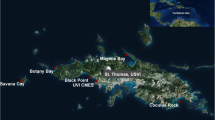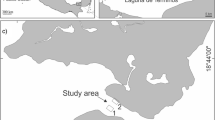Abstract
We manipulated live sponges in Belize, Central America, Big Pine Key, Florida (USA), and Indian River lagoon, Florida (USA) in summer/autumn, 1988. At each location, live sponges of three species were placed within 0.5 cm of ceramic tiles. Tiles with synthetic sponges positioned in the same manner and tiles with no sponges served as controls. Of 26 recruiting species analyzed, only one (Sponge sp. 6 — Indian River) was inhibited by living sponges. Four species (Perophora regina — Belize;Aiptasia pallida — Big Pine Key; andCrassostrea virginica andAscidia nigra — Indian River) recruited in greater numbers in the presence of sponges, suggesting that some larvae may be attracted rather than repelled by sponge allelochemicals. Allelopathic effects were less important than small-scale flow effects and patchy larval supply in determining recruitment patterns on surfaces adjacent to sponges.
Similar content being viewed by others
Literature cited
Bak, R. P. M., Borsboom, J. L. A. (1984). Allelopathic interaction between a reef coelenterate and benthic algae. Oecologia 63: 194–198
Baker, B. J., Scheuer, P. J., Shoolery, J. N. (1988). Papuamine, an antifungal pentacyclic alkaloid from a marine sponge,Haliclona sp. J. Am. chem. Soc. 110: 965–966
Bakus, G. J., Evans, T., Mading, B. Kouros, P. (1983). The use of natural and synthetic toxins as shark repellents and antifouling agents. Toxicon (Suppl. 3). 25–27
Bakus, G. J., Green, G. (1974). Toxicity in sponges and holothurians: a geographic pattern. Science, N.Y. 185: 951–953
Bakus, G. J., Kawaguchi, M. (1984). Toxins from marine organisms: studies on antifouling. In: Bolis, L., Zadunaisky, J., Gilles, R. (eds.) Toxins, drugs, and pollutants in marine animals. Springer-Verlag, Berlin, p. 43–46
Bakus, G. J., Targett, N. M., Schulte, B. (1986). Chemical ecology of marine organisms: an overview. J. chem. Ecol. 12: 951–987
Bingham, B. L. (1990). The ecology of epifaunal communities on prop roots of the red mangrove,Rhizophora mangle. Ph.D. dissertation. Florida State University, Tallahassee
Burkholder, P. R. (1973). The ecology of marine antibiotics and coral reefs. In: Jones, O. A., Endean, R. (eds.) Biology and geology of coral reefs. Academic Press, New York, p. 117–182
Burreson, B. J., Christophersen, C., Scheuer, P. J. (1975). Co-occurrence of two terpenoid isocyanine-formamide pairs in a marine sponge (Halichondria sp.). Tetrahedron 31: 2015–2018
Capon, R. J., Ghisalberti, E. L., Jefferies, P. R. (1982). New tetrahydropyrans from a marine sponge. Tetrahedron 38: 1699–1703
Carballeira, N. M., Maldonado, L. (1986). Identification of 5,9-hexadecadienoic acid in the marine spongeChondrilla nucula. Lipids 21: 470–471
Cimino, G., De Stefano, S., Minale, L. (1973). Methyl trans-monocyclofarnesate from the spongeHalichondria panicea. Experientia 29: 1063–1064
Davis, A. R., Targett, N. M., McConnell, O. J., Young, C. M. (1989). Epibiosis of marine algae and benthic invertebrates: natural products chemistry and other mechanisms inhibiting settlement and overgrowth. In: Scheuer, P. J. (ed.) Bioorganic marine chemistry. Vol. 3. Springer-Verlag, Berlin, p. 85–114
Delseth, C., Tolela, L., Scheuer, P. J., Wells, R. J., Djerassi, C. (1979). 5-alpha-24 norcholestan-3-beta-ol and 24 z stigmasta-5,7,24,28-trien-3-beta-ol: two new marine sterols from the Pacific spongesTerpios zeteki andDysidea herbacea. Helv. chim. Acta 62: 101–109
Dyrynda, P. E. J. (1985). Chemical defences and the structure of subtidal epibenthic communities. Proc. 19th Eur. mar. Biol. Symp. 411–421 [Gibbs, P. E. (ed.) Cambridge University Press, Cambridge]
Fahy, E., Molinski, T. F., Harper, M. K., Sullivan, B. W., Faulkner, D. J., Parkanyi, L., Clardy, J. (1988). Haliclonadiamine, an antimicrobial alkaloid from the spongeHaliclona sp. Tetrahedron Lett. 29: 3427–3428
Faulkner, D. J. (1978). Antibiotics from marine organisms. In: Sammes, P. G. (ed.) Topics in antibiotic chemistry. Vol. 2. John Wiley & Sons, Chichester, p. 9–58
Gaines, S., Brown, S., Roughgarden, J. (1985). Spatial variation in larval concentrations as a cause of spatial variation in settlement for the barnacle,Balanus glandula. Oecologia 67: 267–272
Gaines, S., Roughgarden, J. (1985). Larval settlement rate: a leading determinant of structure in an ecological community of the marine intertidal zone. Proc. natn. Acad. Sci. U.S.A. 82: 3707–3711
Goodbody, I. (1961). Inhibition of the development of a marine sessile community. Nature, Lond. 190: 282–283
Gopichand, Y., Schmitz, F. J. (1979). Two novel lactams from the marine spongeHalichondria melanodocia. J. org. Chem. 44: 4995–4997
Green, G. (1977). Ecology of toxicity in marine sponges. Mar. Biol. 40: 207–215
Grosberg, R. K. (1982). Intertidal zonation of barnacles: the influence of planktonic zonation of larvae on vertical distribution of adults. Ecology 63: 894–899
Hirata, Y., Uemura, D. (1986). Halichondrins-antitumor polyether macrolides from a marine sponge. Pure appl. Chem. 58: 701–710
Hyman, L. H. (1940). The invertebrates. Protozoa through Ctenophora. Vol. 1. McGraw-Hill, New York
Jackson, J. B. C. (1983). Biological determinants of present and past sessile animal distributions. In: Tevesz, M. J. S., McCail, P. L. (eds.) Biotic interactions in recent and fossil benthic communities. Plenum Publishing Corp., New York, p. 39–120
Jackson, J. B. C., Buss, L. (1975). Allelopathy and spatial competition among coral reef invertebrates. Proc. natn. Acad. Sci. U.S.A. 72: 5160–5163
Kernan, M. R., Faulkner, D. J. (1987). Halichondramide, an antifungal macrolide from the spongeHalichondria sp. Tetrahedron Lett. 28: 2809–2812
Kernan, M. R., Molinski, T. F., Faulkner, D. J. (1988). Macrocyclic antifungal metabolites from the Spanish dancer nudibranchHexabranchus sanguineus and sponges of the genusHalichondria. J. org. Chem. 53: 5014–5020
Kirk, R. E. (1982). Experimental design: procedures for the behavioral sciences. Brooks/Cole Publishing Co., Monterey, California
McCaffrey, E. J., Endean, R. (1985). Antimicrobial activity of tropical and subtropical sponges. Mar. Biol. 89: 1–8
Mebs, D., Weiler, I., Heinke, H. F. (1985). Bioactive proteins from marine sponges: screening of sponge extracts for hemagglutinating, hemolytic, ichthyotoxic and lethal properties and isolation and characterization of hemagglutinins. Toxicon 23: 955–962
Molinski, T. F., Faulkner, D. J., Van Duyne, G. D., Clardy, J. (1987). Three new diterpene isonitriles from a Palauan sponge of the genusHalichondria. J. org. Chem. 62: 3334–3337
Nakagawa, M., Hamamoto, Y., Ishihama, M., Hamasaki, S., Endo, M. (1987). Pharmacologically active homosesterterpenes from Palauan sponges. Tetrahedron Lett. 28: 431–434
Porter, J. W., Targett, N. M. (1988). Allelochemical interactions between sponges and corals. Biol. Bull. mar. biol. Lab., Woods Hole 175: 230–239
Sakai, R., Higa, T., Jefford, C. W., Bernardinelli, G. (1986). Manzamine A, a novel antitumor alkaloid from a sponge. J. Am. chem. Soc. 108: 6404–6405
Sammarco, P. W., Coll, J. C. (1988). The chemical ecology of alcyonarian corals. Coelenterata: Octocorallia. In: Scheuer P. J. (ed.) Bioorganic marine chemistry. Vol. 2. Springer-Verlag, Berlin, p. 87–116
Sammarco, P. W., Coll, J. C., La Barre, S. (1985). Competitive strategies of soft corals (Coelenterata: Octocorallia): II. Variable defensive response and susceptibility to scleractinian corals. J. exp. mar. Biol. Ecol. 91: 199–215
Schmitz, F. J., Gunasekera, S. P., Lakshmi, V., Tillekeratne, L. M. V. (1985). Marine natural products: pyrrolactams from several sponges. J. nat. Products (Lloydia) 48: 47–53
Schmitz, F. J., Gunasekera, S. P., Yalamanchili, G., Hossain, M. B., van der Helm, D. (1984). Tedanolide: a potent cytotoxic macrolide from the Caribbean spongeTedania ignis. J. Am. chem. Soc. 106: 7251–7252
Schmitz, F. J., Hollenbeak, K. H., Campbell, D. C. (1978). Marine natural products: halitoxin, toxic complex of several marine sponges of the genusHaliclona. J. org. Chem. 43: 3916–3922
Schmitz, F. J., McDonald, F. J. (1974). Isolation and identification of cerebrosides from the marine spongeChondrilla nucula. J. Lipid Res. 15: 158–164
Schmitz, F. J., Vanderah, D. J., Hollenbeak, K. H., Enwall, C. E. L., Gopichand, Y., SenGupta, P. K., Hossain, M. B., van der Helm, D. (1983). Metabolites from the marine spongeTedania ignis. A new antisanediol and several known diketopiperazines. J. org. Chem. 48: 3941–3945
Sheikh, Y. M., Djerassi, C. (1974). Steroids from sponges. Tetrahedron 30: 4095–4103
Sullivan, B. W., Faulkner, D. J., Okamoto, K. T., Chen, M. H. M., Clardy, J. (1986). (6R, 7S)-7-amino-7,8-dihydro-α-bisabolene, an antimicrobial metabolite from the marine spongeHalichondria sp. J. org. Chem. 51: 5134–5136
Sullivan, B., Faulkner, D. J., Webb, L. (1983). Siphonodictidine, a metabolite of the burrowing spongeSiphonodictyon sp. that inhibits coral growth. Science, N.Y. 221: 1175–1176
Tachibana, K., Scheuer, P. J., Tsukitani, Y., Kikuchi, H., Van Engen, D., Clardy, J., Gopichand, Y., Schmitz, F. J. (1981). Okadaic acid, a cytotoxic polyether from two marine sponges of the genusHalichondria. J. Am. chem. Soc. 103: 2469–2471
Targett, N. M. (1988). Allelochemistry in marine organisms: chemical fouling and antifouling strategies. In: Thompson, M. F., Sarojini, R., Nagabhushanam, R. (eds.) Marine biodeterioration: advanced techniques applicable to the Indian Ocean. Oxford & IBH Publishing Co., New Delhi, p. 609–617
Thompson, J. E. (1984). Chemical ecology and the structure of sponge dominated assemblages. Ph.D. thesis. University of California, San Diego
Thompson, J. E. (1985). Exudation of biologically-active metabolites in the spongeAplysina fistularis. I. Biological evidence. Mar. Biol. 88: 23–26
Thompson, J. E., Walker, R. P., Faulkner, D. J. (1985). Screening and bioassays for biologically-active substances from forty marine sponge species from San Diego, California, USA. Mar. Biol. 88: 11–21
Uemura, D., Takahashi, K., Yamamoto, T., Katayama, C., Tanaka, J., Okumura, Y., Hirata, Y. (1985). Norhalichondrin A: an antitumor polyether macrolide from a marine sponge. J. Am. chem. Soc. 107: 4796–4798
Ware, G. N. (1984). The patterns and mechanisms of antifouling in some temperate marine sponges. Thesis. Duke University, Durham, North Carolina
Winer, B. J. (1971). Statistical principles in experimental design. McGraw-Hill, New York
Zaro, B. A. (1982). Marine sponges: a source of novel antibiotics. Proc. west. Pharmac. Soc. (U.S.) 25: 11–13
Author information
Authors and Affiliations
Additional information
Communicated by J.M. Lawrence, Tampa
Rights and permissions
About this article
Cite this article
Bingham, B.L., Young, C.M. Influence of sponges on invertebrate recruitment: A field test of allelopathy. Mar. Biol. 109, 19–26 (1991). https://doi.org/10.1007/BF01320227
Accepted:
Issue Date:
DOI: https://doi.org/10.1007/BF01320227




